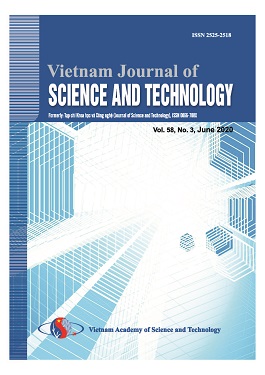Adsorption of mercuric ion from aqueous solutions using modified fly ash
Author affiliations
DOI:
https://doi.org/10.15625/2525-2518/56/6/12664Keywords:
(3-Mercaptopropyl) triethoxysilane, fly ash, mercuric ion absorption, adsorption isotherm modelsAbstract
In this study, fly ash was treated with NaOH solution (FAN) before modifying with (3-mercaptopropyl) triethoxysilane - MPTMS (FAMPS). By using FTIR, FESEM, XRD, EDX, and BET techniques, the change in structure, composition and morphology of FAN and FAMPS was evaluated. The FTIR spectra of FAN and FAMPS showed that there is no chemical reaction between the MPTMS and FAN. After modification, the FAMPS has a rough surface with composition difference from the FAN. Mercuric ion adsorption behavior as well as adsorptionisotherm models (Langmuir and Freundlich) of the FAN and FAMPS were also investigated and discussed. Thanks to FAN modification, the mercuric ion removal percent of the FAMPS was higher than that of the FAN. Owing to the adsorption data, Freundlich isotherm modelwas fitted for the mercuric ion adsorption process.Downloads
References
Ghosal S., Self S. A. - Particle size-density relation and cenosphere content of coal fly ash, Fuel 74(4) (1995) 522-529.
Shaobin W., Hongwei W. - Environmental – benign utilisation of fly as low –cost adsorbents, Journal of Hazardous Materials B136 (2006) 482 – 501.
Agarwal S., Rani A. - Adsorption of resorcinol from aqueous solution onto CTAB/NaOH/flyash composites: Equilibrium, kinetics and thermodynamics, Journal of Environmental Chemical Engineering 5 (2017) 526–538.
Chatterjee D., Patnam V. R., Sikdar A., and Moulik S. K. - Removal of some common textile dyes from aqueous solution using fly ash, J. Chem. Eng. Data 55(12) (2010) 5653–5657.
Sharan R., Singh G., Gupta S. K. - Adsorption of phenol from aqueous solution onto fly ash from a thermal power plant, Adsorption Science & Technology 27(3) (2009) 267-279.
Halas P., Kolodynska D., Plaza A., Geca M., Hubicki Z. - Modified fly ash and zeolites as an effective adsorbent for metal ions from aqueous solution, Adsorption Science & Technology 35(5-6) (2017) 519–533.
Ji X. D., Ma Y. Y., Peng S. H., Gong Y. Y., Zhang F. - Simultaneous removal of aqueous Zn2+, Cu2+, Cd2+, and Pb2+ by zeolites synthesized from low-calcium and high-calcium fly ash, Water Science & Technology 76(7-8) (2017) 2106-2119.
Pehlivan E., Cetin S. - Application of fly ash and activated carbon in the removal of Cu2+ and Ni2+ ions from aqueous solutions, Energy Sources, Part A: Recovery, Utilization, and Environmental Effects 30 (2008) 1153-1165.
Sasithorn J., Wiwattanadate D. and Sangsuk S. - Utilization of fly ash from power plant for adsorption of hydrocarbon contamination in water, Journal of Metals, Materials and Minerals 20(1) (2010) 5-10.
Singh D. - Studies of the adsorption thermodynamics of oxamyl on fly ash, Adsorption Science & Technology 18(8) (2000) 741-748.
Visa M., Duta A. - Methyl-orange and cadmium simultaneous removal using fly ash and photo-Fenton systems, J. Hazard. Mater. 244 (2013) 773–779.
Visa M., Isac L., Duta A. - Fly ash adsorbents for multi-cation wastewater treatment, Applied Surface Science 258 (2012) 6345– 6352.
Gupta R. K., Singh R. A., Dubey S. S. - Removal of mercury ions from aqueous solutions by composite of polyaniline with polystyrene, Separation and Purification Technology 38(3) (2004) 225-232.
Chinh N. T., Mai T. T., Trang N. T. T., Huong N. T. T., Hoang T. - Using fly ash treated by NaOH and H2SO4 solutions for Hg2+ and Cd2+ ion adsorption, Journal of Chemistry 55(2) (2017) 196-201.
Özlem Ç., Damci E., Pişkin S. - Characterization of fly ash and its effects on the compressive strength properties of Portland cement, Indian Journal of Engineering and Materials Sciences 15(5) (2008) 433-440.
Hoang T., Chinh N. T., Khu L. V., Trang N. T. T. - Study on the modification of nanosilica with 3-aminopropyltriethoxy silane, Journal of Chemistry 51(1) (2013) 45-49.
Downloads
Published
How to Cite
Issue
Section
License

This work is licensed under a Creative Commons Attribution-ShareAlike 4.0 International License.
Vietnam Journal of Sciences and Technology (VJST) is an open access and peer-reviewed journal. All academic publications could be made free to read and downloaded for everyone. In addition, articles are published under term of the Creative Commons Attribution-ShareAlike 4.0 International (CC BY-SA) Licence which permits use, distribution and reproduction in any medium, provided the original work is properly cited & ShareAlike terms followed.
Copyright on any research article published in VJST is retained by the respective author(s), without restrictions. Authors grant VAST Journals System a license to publish the article and identify itself as the original publisher. Upon author(s) by giving permission to VJST either via VJST journal portal or other channel to publish their research work in VJST agrees to all the terms and conditions of https://creativecommons.org/licenses/by-sa/4.0/ License and terms & condition set by VJST.
Authors have the responsibility of to secure all necessary copyright permissions for the use of 3rd-party materials in their manuscript.







 Vietnam Journal of Science and Technology (VJST) is pleased to notice:
Vietnam Journal of Science and Technology (VJST) is pleased to notice: